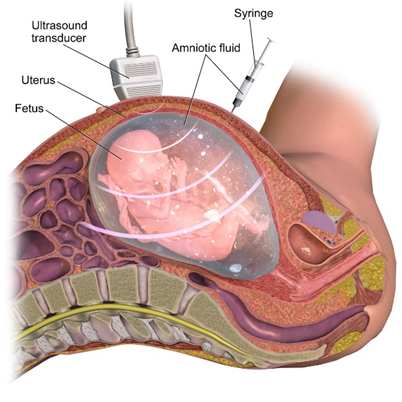A client at 20 weeks gestation reports discomfort after amniocentesis procedure to the nurse. Which of the following assessment findings warrants priority action by the nurse?
Braxton Hicks contraction
Amniotic fluid contains fetal urine
Prolonged vaginal bleeding
Lab results reveal abnormal chromosome cells
The Correct Answer is C
Explanation:
A. Braxton Hicks contraction
Braxton Hicks contractions are often referred to as "practice" contractions and are common during pregnancy. They are typically irregular and do not cause cervical changes. While discomfort after an amniocentesis procedure can sometimes trigger Braxton Hicks contractions, they are not usually a cause for immediate concern unless they become frequent, intense, or are accompanied by other signs of preterm labor, such as regular contractions, lower back pain, pelvic pressure, or changes in vaginal discharge.
B. Amniotic fluid contains fetal urine
The presence of fetal urine in the amniotic fluid is a normal and expected process during pregnancy. Fetal urine production contributes to the volume and composition of amniotic fluid, helping maintain the environment in the uterus and supporting fetal development. This finding is not directly related to the client's discomfort after an amniocentesis procedure and is not a cause for immediate concern unless there are other complications or abnormalities related to the amniotic fluid composition.
C. Prolonged vaginal bleeding
Prolonged vaginal bleeding after an amniocentesis procedure is a significant finding that requires immediate attention. While some spotting or mild bleeding can occur after the procedure, prolonged or significant bleeding may indicate complications such as uterine injury, placental abruption, or other issues that need urgent assessment and intervention by healthcare providers.

D. Lab results reveal abnormal chromosome cells
Abnormal chromosome cells found in the amniotic fluid sample obtained during amniocentesis may indicate genetic abnormalities or conditions in the fetus. While this finding is significant and requires follow-up and further evaluation, it is not an immediate concern in terms of the client's discomfort or the need for priority action by the nurse unless it is associated with other urgent clinical signs or symptoms.
Nursing Test Bank
Naxlex Comprehensive Predictor Exams
Related Questions
Correct Answer is A
Explanation
Explanation:
A. "Daily jogging for up to 30 minutes is fine throughout the pregnancy."
This response suggests that moderate-intensity exercise like jogging is safe throughout pregnancy. However, it's important to note that individual exercise recommendations can vary based on the woman's health status, pre-pregnancy fitness level, any pregnancy complications, and guidance from her healthcare provider. While moderate exercise is generally encouraged during pregnancy, it's crucial for the client to consult her healthcare provider for personalized recommendations.
B. "Activities that raise the body temperature, such as saunas and hot tubs, are safe until the third trimester."
This response addresses the importance of avoiding activities that can lead to overheating, such as using saunas or hot tubs, especially during the first trimester when fetal development is particularly sensitive. However, it doesn't specifically address general exercise guidelines.
C. "It is recommended that pregnant clients limit their exercise routine to stretching activities on a mat several times a week."
This response suggests a very conservative approach to exercise during pregnancy, focusing primarily on stretching activities. While stretching can be beneficial, it's important for pregnant individuals to engage in a variety of exercises, including aerobic and strength-training activities, as long as they are safe and appropriate for their pregnancy status.
D. "Exercising during pregnancy is not recommended."
This response is not accurate. Exercise during pregnancy is generally recommended and has numerous benefits for both the mother and baby, including improved cardiovascular health, reduced risk of gestational diabetes, enhanced mood, and better overall well-being. However, the type, intensity, and duration of exercise should be tailored to the individual's needs and guided by healthcare providers.
Correct Answer is ["B","C","D"]
Explanation
Explanation:
A. Evaluate neurologic status every 8 hr.
While monitoring neurologic status is important in clients with severe gestational hypertension to assess for signs of impending eclampsia (seizures), more frequent monitoring is typically required, such as every 4 hours or even more frequently depending on the severity of the condition. Therefore, evaluating neurologic status every 8 hours is not sufficient for this client.
B. Provide a dark, quiet environment.
Creating a calm and low-stimulation environment helps to reduce the risk of seizures, which can be triggered by bright lights and loud noises in clients with severe gestational hypertension.
C. Administer magnesium sulfate IV.
Magnesium sulfate is commonly used to prevent seizures in clients with severe gestational hypertension (preeclampsia). It is a standard treatment to prevent eclampsia, a serious complication of preeclampsia characterized by seizures. Therefore, the nurse should expect to administer magnesium sulfate IV as part of the management plan for severe gestational hypertension.
D. Ensure that calcium gluconate is readily available.
Magnesium sulfate, while effective in preventing seizures, can lead to magnesium toxicity if levels become too high. Calcium gluconate is the antidote for magnesium sulfate toxicity. Therefore, the nurse should ensure that calcium gluconate is readily available to counteract any potential magnesium toxicity that may occur during magnesium sulfate administration.
E. Assess respiratory status every 4 hr.
Monitor and record vital signs (blood pressure, pulse, respirations, O2 saturation) every 1 hour x’s 8 hours after maintenance infusion is started and vital signs for bolus infusion are complete.If respiratory rate < 12 breaths/min, draw magnesium level, notify HCP, and observe closely.
Whether you are a student looking to ace your exams or a practicing nurse seeking to enhance your expertise , our nursing education contents will empower you with the confidence and competence to make a difference in the lives of patients and become a respected leader in the healthcare field.
Visit Naxlex, invest in your future and unlock endless possibilities with our unparalleled nursing education contents today
Report Wrong Answer on the Current Question
Do you disagree with the answer? If yes, what is your expected answer? Explain.
Kindly be descriptive with the issue you are facing.
